3.2.1: Double Integrals Part 1 (Exercises)
- Last updated
- Dec 18, 2020
- Save as PDF
- Page ID
- 54087
( \newcommand{\kernel}{\mathrm{null}\,}\)
In exercises 1 and 2, use the midpoint rule with m=4 and n=2 to estimate the volume of the solid bounded by the surface z=f(x,y), the vertical planes x=1, x=2, y=1, and y=2, and the horizontal plane z=0.
1) f(x,y)=4x+2y+8xy
- Answer
- 27
2) f(x,y)=16x2+y2
In exercises 3 and 4, estimate the volume of the solid under the surface z=f(x,y) and above the rectangular region R by using a Riemann sum with m=n=2 and the sample points to be the lower left corners of the sub-rectangles of the partition.
3) f(x,y)=sinx−cosy, R=[0,π]×[0,π]
- Answer
- 0
4) f(x,y)=cosx+cosy, R=[0,π]×[0,π2]
5) Use the midpoint rule with m=n=2 to estimate ∬, where the values of the function f on R = [8,10] \times [9,11] are given in the following table.
| y | |||||
|---|---|---|---|---|---|
| x | 9 | 9.5 | 10 | 10.5 | 11 |
| 8 | 9.8 | 5 | 6.7 | 5 | 5.6 |
| 8.5 | 9.4 | 4.5 | 8 | 5.4 | 3.4 |
| 9 | 8.7 | 4.6 | 6 | 5.5 | 3.4 |
| 9.5 | 6.7 | 6 | 4.5 | 5.4 | 6.7 |
| 10 | 6.8 | 6.4 | 5.5 | 5.7 | 6.8 |
- Answer
- 21.3
6) The values of the function f on the rectangle R = [0,2] \times [7,9] are given in the following table. Estimate the double integral \iint_R f(x,y)\,dA by using a Riemann sum with m = n = 2. Select the sample points to be the upper right corners of the sub-squares of R.
| y_0 = 7 | y_1 = 8 | y_2 = 9 | |
|---|---|---|---|
| x_0 = 0 | 10.22 | 10.21 | 9.85 |
| x_1 = 1 | 6.73 | 9.75 | 9.63 |
| x_2 = 2 | 5.62 | 7.83 | 8.21 |
7) The depth of a children’s 4-ft by 4-ft swimming pool, measured at 1-ft intervals, is given in the following table.
- Estimate the volume of water in the swimming pool by using a Riemann sum with m = n = 2. Select the sample points using the midpoint rule on R = [0,4] \times [0,4].
- Find the average depth of the swimming pool.
y x 0 1 2 3 4 0 1 1.5 2 2.5 3 1 1 1.5 2 2.5 3 2 1 1.5 1.5 2.5 3 3 1 1 1.5 2 2.5 4 1 1 1 1.5 2
- Answer
- a. 28 \text{ft}^3
b. 1.75 ft.
8) The depth of a 3-ft by 3-ft hole in the ground, measured at 1-ft intervals, is given in the following table.
- Estimate the volume of the hole by using a Riemann sum with m = n = 3 and the sample points to be the upper left corners of the sub-squares of R.
- Find the average depth of the hole.
y x 0 1 2 3 0 6 6.5 6.4 6 1 6.5 7 7.5 6.5 2 6.5 6.7 6.5 6 3 6 6.5 5 5.6
9) The level curves f(x,y) = k of the function f are given in the following graph, where k is a constant.
- Apply the midpoint rule with m = n = 2 to estimate the double integral \iint_R f(x,y)\,dA, where R = [0.2,1] \times [0,0.8].
- Estimate the average value of the function f on R.
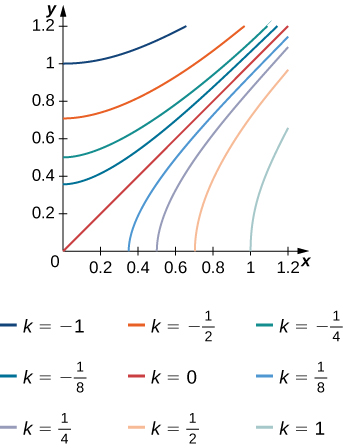
- Answer
- a. Answers will vary somewhat, but should be close to these: f(0.4,0.2) \approx 0.125, f(0.4,0.6) \approx− 0.2, f(0.8,0.2) \approx 0.6, and f(0.8,0.6) \approx 0.3.
Since the area of each rectangle is \Delta A_i = (0.4)(0.4) = 0.16 \text{ units}^2, \displaystyle \iint_R f(x,y)\,dA = \int_{0.2}^{1}\int_{0}^{0.8} f(x,y) \,dy\,dx \approx f(0.4,0.2)(0.16)+f(0.4,0.6)(0.16) +f(0.8,0.2) (0.16) + f(0.8,0.6)(0.16) = 0.132
b. f_{ave} = \dfrac{\int_{0.2}^{1}\int_{0}^{0.8} f(x,y) \,dy\,dx}{\text{area of }R}\approx \dfrac{\int_{0.2}^{1}\int_{0}^{0.8} f(x,y) \,dy\,dx}{0.64} \approx 0.206
10) The level curves f(x,y) = k of the function f are given in the following graph, where k is a constant.
- Apply the midpoint rule with m = n = 2 to estimate the double integral \iint_R f(x,y)\,dA, where R = [0.1,0.5] \times [0.1,0.5].
- Estimate the average value of the function f on R.
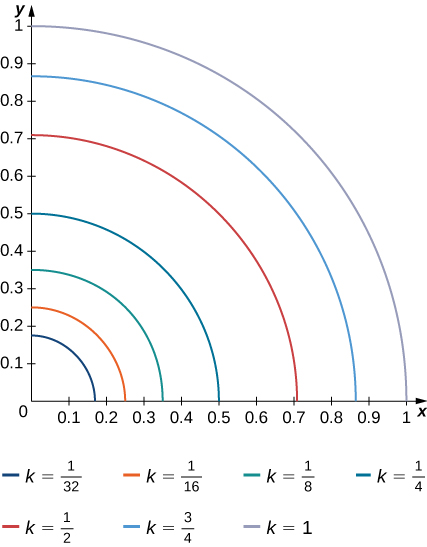
11) The solid lying under the surface z = \sqrt{4 - y^2} and above the rectangular region R = [0,2] \times [0,2] is illustrated in the following graph. Evaluate the double integral \iint_Rf(x,y), where f(x,y) = \sqrt{4 - y^2} by finding the volume of the corresponding solid.
- Answer
- 2\pi
12) The solid lying under the plane z = y + 4 and above the rectangular region R = [0,2] \times [0,4] is illustrated in the following graph. Evaluate the double integral \iint_R f(x,y)\,dA, where f(x,y) = y + 4, by finding the volume of the corresponding solid.
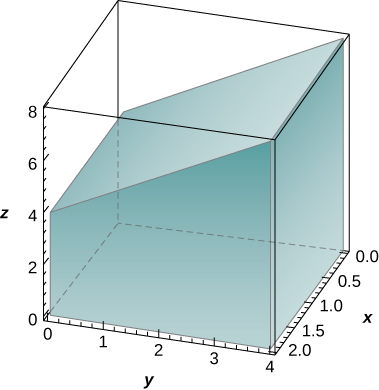
In the exercises 13 - 20, calculate the integrals by reversing the order of integration.
13) \displaystyle \int_{-1}^1\left(\int_{-2}^2 (2x + 3y + 5)\,dx \right) \space dy
- Answer
- 40
14) \displaystyle \int_0^2\left(\int_0^1 (x + 2e^y + 3)\,dx \right) \space dy
15) \displaystyle \int_1^{27}\left(\int_1^2 (\sqrt[3]{x} + \sqrt[3]{y})\,dy \right) \space dx
- Answer
- \frac{81}{2} + 39\sqrt[3]{2}
16) \displaystyle \int_1^{16}\left(\int_1^8 (\sqrt[4]{x} + 2\sqrt[3]{y})\,dy \right) \space dx
17) \displaystyle \int_{\ln 2}^{\ln 3}\left(\int_0^1 e^{x+y}\,dy \right) \space dx
- Answer
- e - 1
18) \displaystyle \int_0^2\left(\int_0^1 3^{x+y}\,dy \right) \space dx
19) \displaystyle \int_1^6\left(\int_2^9 \frac{\sqrt{y}}{x^2}\,dy \right) \space dx
- Answer
- 15 - \frac{10\sqrt{2}}{9}
20) \displaystyle \int_1^9 \left(\int_4^2 \frac{\sqrt{x}}{y^2}\,dy \right)\,dx
In exercises 21 - 34, evaluate the iterated integrals by choosing the order of integration.
21) \displaystyle \int_0^{\pi} \int_0^{\pi/2} \sin(2x)\cos(3y)\,dx \space dy
- Answer
- 0
22) \displaystyle \int_{\pi/12}^{\pi/8}\int_{\pi/4}^{\pi/3} [\cot x + \tan(2y)]\,dx \space dy
23) \displaystyle \int_1^e \int_1^e \left[\frac{1}{x}\sin(\ln x) + \frac{1}{y}\cos (\ln y)\right] \,dx \space dy
- Answer
- (e − 1)(1 + \sin 1 − \cos 1)
24) \displaystyle \int_1^e \int_1^e \frac{\sin(\ln x)\cos (\ln y)}{xy} \,dx \space dy
25) \displaystyle \int_1^2 \int_1^2 \left(\frac{\ln y}{x} + \frac{x}{2y + 1}\right)\,dy \space dx
- Answer
- \frac{3}{4}\ln \left(\frac{5}{3}\right) + 2 (\ln 2)^2 - \ln 2
26) \displaystyle \int_1^e \int_1^2 x^2 \ln(x)\,dy \space dx
27) \displaystyle \int_1^{\sqrt{3}} \int_1^2 y \space \arctan \left(\frac{1}{x}\right) \,dy \space dx
- Answer
- \frac{1}{8}[(2\sqrt{3} - 3) \pi + 6 \space \ln 2]
28) \displaystyle \int_0^1 \int_0^{1/2} (\arcsin x + \arcsin y)\,dy \space dx
29) \displaystyle \int_0^1 \int_1^2 xe^{x+4y}\,dy \space dx
- Answer
- \frac{1}{4}e^4 (e^4 - 1)
30) \displaystyle \int_1^2 \int_0^1 xe^{x-y}\,dy \space dx
31) \displaystyle \int_1^e \int_1^e \left(\frac{\ln y}{\sqrt{y}} + \frac{\ln x}{\sqrt{x}}\right)\,dy \space dx
- Answer
- 4(e - 1)(2 - \sqrt{e})
32) \displaystyle \int_1^e \int_1^e \left(\frac{x \space \ln y}{\sqrt{y}} + \frac{y \space \ln x}{\sqrt{x}}\right)\,dy \space dx
33) \displaystyle \int_0^1 \int_1^2 \left(\frac{x}{x^2 + y^2} \right)\,dy \space dx
- Answer
- -\frac{\pi}{4} + \ln \left(\frac{5}{4}\right) - \frac{1}{2} \ln 2 + \arctan 2
34) \displaystyle \int_0^1 \int_1^2 \frac{y}{x + y^2}\,dy \space dx
In exercises 35 - 38, find the average value of the function over the given rectangles.
35)f(x,y) = −x +2y, R = [0,1] \times [0,1]
- Answer
- \frac{1}{2}
36) f(x,y) = x^4 + 2y^3, R = [1,2] \times [2,3]
37) f(x,y) = \sinh x + \sinh y, R = [0,1] \times [0,2]
- Answer
- \frac{1}{2}(2 \space \cosh 1 + \cosh 2 - 3).
38) f(x,y) = \arctan(xy), R = [0,1] \times [0,1]
39) Let f and g be two continuous functions such that 0 \leq m_1 \leq f(x) \leq M_1 for any x ∈ [a,b] and 0 \leq m_2 \leq g(y) \leq M_2 for any y ∈ [c,d]. Show that the following inequality is true:
m_1m_2(b-a)(c-d) \leq \int_a^b \int_c^d f(x) g(y)\,dy dx \leq M_1M_2 (b-a)(c-d). \nonumber
In exercises 40 - 43, use property v. of double integrals and the answer from the preceding exercise to show that the following inequalities are true.
40) \frac{1}{e^2} \leq \iint_R e^{-x^2 - y^2} \space dA \leq 1, where R = [0,1] \times [0,1]
41) \frac{\pi^2}{144} \leq \iint_R \sin x \cos y \space dA \leq \frac{\pi^2}{48}, where R = \left[ \frac{\pi}{6}, \frac{\pi}{3}\right] \times \left[ \frac{\pi}{6}, \frac{\pi}{3}\right]
42) 0 \leq \iint_R e^{-y}\space \cos x \space dA \leq \frac{\pi}{2}, where R = \left[0, \frac{\pi}{2}\right] \times \left[0, \frac{\pi}{2}\right]
43) 0 \leq \iint_R (\ln x)(\ln y) \,dA \leq (e - 1)^2, where R = [1, e] \times [1, e]
44) Let f and g be two continuous functions such that 0 \leq m_1 \leq f(x) \leq M_1 for any x ∈ [a,b] and 0 \leq m_2 \leq g(y) \leq M_2 for any y ∈ [c,d]. Show that the following inequality is true:
(m_1 + m_2) (b - a)(c - d) \leq \int_a^b \int_c^d |f(x) + g(y)| \space dy \space dx \leq (M_1 + M_2)(b - a)(c - d) \nonumber
In exercises 45 - 48, use property v. of double integrals and the answer from the preceding exercise to show that the following inequalities are true.
45) \frac{2}{e} \leq \iint_R (e^{-x^2} + e^{-y^2}) \,dA \leq 2, where R = [0,1] \times [0,1]
46) \frac{\pi^2}{36}\iint_R (\sin x + \cos y)\,dA \leq \frac{\pi^2 \sqrt{3}}{36}, where R = [\frac{\pi}{6}, \frac{\pi}{3}] \times [\frac{\pi}{6}, \frac{\pi}{3}]
47) \frac{\pi}{2}e^{-\pi/2} \leq \iint_R (\cos x + e^{-y})\,dA \leq \pi, where R = [0, \frac{\pi}{2}] \times [0, \frac{\pi}{2}]
48) \frac{1}{e} \leq \iint_R (e^{-y} - \ln x) \,dA \leq 2, where R = [0, 1] \times [0, 1]
In exercises 49 - 50, the function f is given in terms of double integrals.
- Determine the explicit form of the function f.
- Find the volume of the solid under the surface z = f(x,y) and above the region R.
- Find the average value of the function f on R.
- Use a computer algebra system (CAS) to plot z = f(x,y) and z = f_{ave} in the same system of coordinates.
49) [T] f(x,y) = \int_0^y \int_0^x (xs + yt) ds \space dt, where (x,y) \in R = [0,1] \times [0,1]
- Answer
-
a. f(x,y) = \frac{1}{2} xy (x^2 + y^2);
b. V = \int_0^1 \int_0^1 f(x,y)\,dx \space dy = \frac{1}{8};
c. f_{ave} = \frac{1}{8};d.
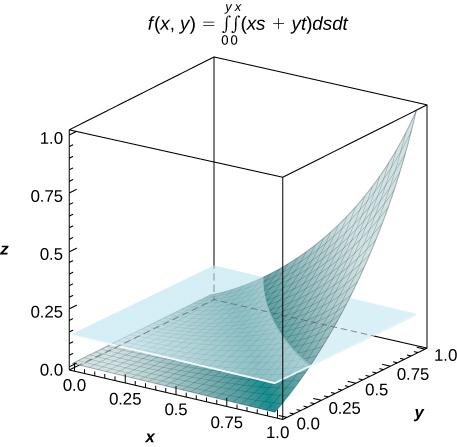
50) [T] f(x,y) = \int_0^x \int_0^y [\cos(s) + \cos(t)] \, dt \space ds, where (x,y) \in R = [0,3] \times [0,3]
51) Show that if f and g are continuous on [a,b] and [c,d], respectively, then
\displaystyle \int_a^b \int_c^d |f(x) + g(y)| dy \space dx = (d - c) \int_a^b f(x)\,dx
\displaystyle + \int_a^b \int_c^d g(y)\,dy \space dx = (b - a) \int_c^d g(y)\,dy + \int_c^d \int_a^b f(x)\,dx \space dy.
52) Show that \displaystyle \int_a^b \int_c^d yf(x) + xg(y)\,dy \space dx = \frac{1}{2} (d^2 - c^2) \left(\int_a^b f(x)\,dx\right) + \frac{1}{2} (b^2 - a^2) \left(\int_c^d g(y)\,dy\right).
53) [T] Consider the function f(x,y) = e^{-x^2-y^2}, where (x,y) \in R = [−1,1] \times [−1,1].
- Use the midpoint rule with m = n = 2,4,..., 10 to estimate the double integral I = \iint_R e^{-x^2 - y^2} dA. Round your answers to the nearest hundredths.
- For m = n = 2, find the average value of f over the region R. Round your answer to the nearest hundredths.
- Use a CAS to graph in the same coordinate system the solid whose volume is given by \iint_R e^{-x^2-y^2} dA and the plane z = f_{ave}.
- Answer
-
a. For m = n = 2, I = 4e^{-0.5} \approx 2.43
b. f_{ave} = e^{-0.5} \simeq 0.61;c.
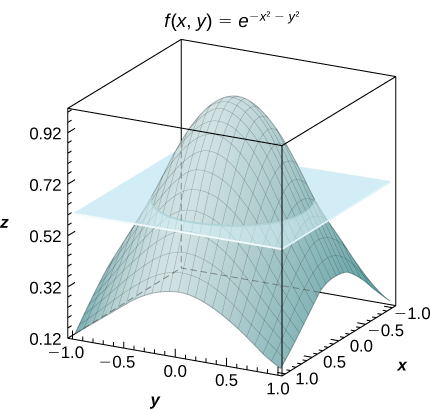
54) [T] Consider the function f(x,y) = \sin (x^2) \space \cos (y^2), where (x,y \in R = [−1,1] \times [−1,1].
- Use the midpoint rule with m = n = 2,4,..., 10 to estimate the double integral I = \iint_R \sin (x^2) \cos (y^2) \space dA. Round your answers to the nearest hundredths.
- For m = n = 2, find the average value of fover the region R. Round your answer to the nearest hundredths.
- Use a CAS to graph in the same coordinate system the solid whose volume is given by \iint_R \sin(x^2) \cos(y^2) \space dA and the plane z = f_{ave}.
In exercises 55 - 56, the functions f_n are given, where n \geq 1 is a natural number.
- Find the volume of the solids S_n under the surfaces z = f_n(x,y) and above the region R.
- Determine the limit of the volumes of the solids S_n as n increases without bound.
55) f(x,y) = x^n + y^n + xy, \space (x,y) \in R = [0,1] \times [0,1]
- Answer
- a. \frac{2}{n + 1} + \frac{1}{4}
b. \frac{1}{4}
56) f(x,y) = \frac{1}{x^n} + \frac{1}{y^n}, \space (x,y) \in R = [1,2] \times [1,2]
57) Show that the average value of a function f on a rectangular region R = [a,b] \times [c,d] is f_{ave} \approx \frac{1}{mn} \sum_{i=1}^m \sum_{j=1}^n f(x_{ij}^*,y_{ij}^*),where (x_{ij}^*,y_{ij}^*) are the sample points of the partition of R, where 1 \leq i \leq m and 1 \leq j \leq n.
58) Use the midpoint rule with m = n to show that the average value of a function f on a rectangular region R = [a,b] \times [c,d] is approximated by
f_{ave} \approx \frac{1}{n^2} \sum_{i,j =1}^n f \left(\frac{1}{2} (x_{i=1} + x_i), \space \frac{1}{2} (y_{j=1} + y_j)\right). \nonumber
59) An isotherm map is a chart connecting points having the same temperature at a given time for a given period of time. Use the preceding exercise and apply the midpoint rule with m = n = 2 to find the average temperature over the region given in the following figure.
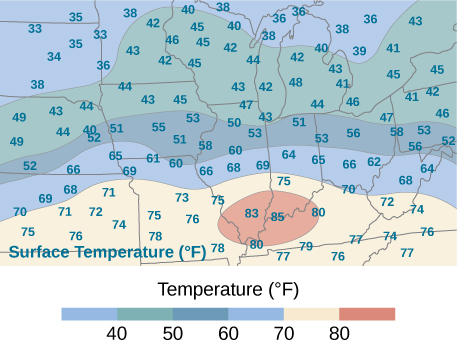
- Answer
- 56.5^{\circ} F; here f(x_1^*,y_1^*) = 71, \space f(x_2^*, y_1^*) = 72, \space f(x_2^*,y_1^*) = 40, \space f(x_2^*,y_2^*) = 43, where x_i^* and y_j^* are the midpoints of the subintervals of the partitions of [a,b] and [c,d], respectively.


